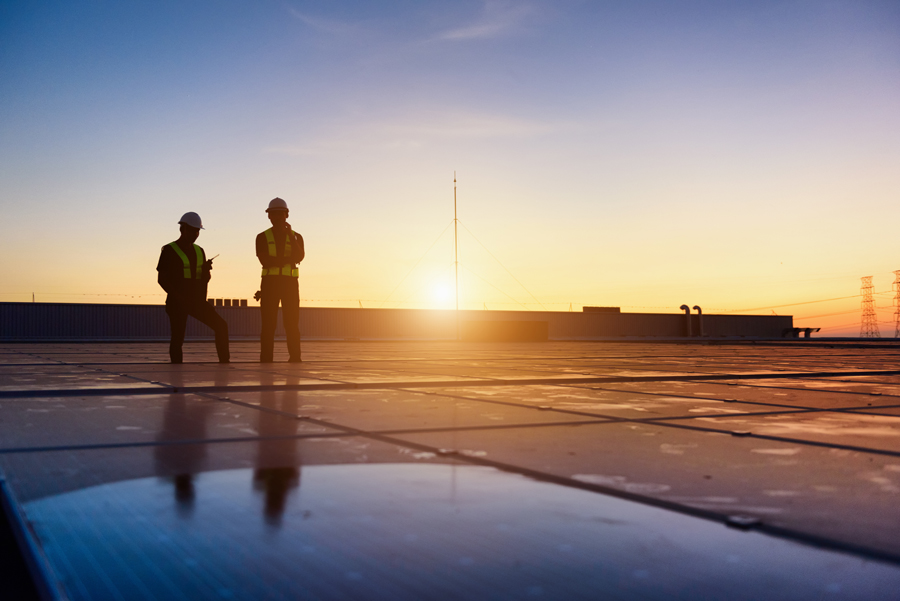Roof damage is not always immediately obvious, but when it goes unnoticed, it can create structural problems and can even devalue your commercial property. Taking care of these problems early can prevent more costly fixes down the road. Identifying commercial roof issues is the first step to getting them repaired.
Knowing what to look for during self-inspections can help diagnose issues and save money with faster maintenance and repairs. In this article, we'll discuss how to inspect your roof, the type of damage that your roof can sustain over time, and how to recognize the signs of this type of damage. When in doubt about the condition of your roof, hire a professional roofing contractor to perform an inspection and recommend repairs.
How to Perform an Inspection
Inspect your commercial roof twice annually, once in the fall and once in the spring. If your commercial roof isn't flat, get help from the professionals to perform the inspection. If your commercial roof is flat and safe to walk on, you can perform the inspection yourself.
While you're on the roof, bring a trash bag to collect debris like leaves and organic material. Remove anything from the roof that shouldn't be there. Organic matter left on some roofing materials can lock in moisture, leading to leaks and deterioration.
During the inspection, check seams, flashing, the membrane and more. The areas most vulnerable to damage include seams and flashing, which tend to deteriorate more quickly than other parts of the roof.
Look for:
- Gashes in the roofing material
- Corrosion
- Missing or damaged caulking
Signs of Damage to Your Commercial Roof
Damage to your commercial roof can include the following:
Punctured membrane. The membrane is the cover that fits over the roof and protects the material beneath. The membrane may become sliced or gashed, depending on the cause. Foot traffic, animals, storm damage and general wear and tear are all potential causes of a punctured membrane. A punctured membrane can be patched, if the rest of the membrane is in good enough condition and the puncture is small enough. Call a roofing contractor to get it repaired.
Creating a dedicated roof walkway system can alleviate the continual strain that comes from roof traffic.
Damaged flashing. Flashing is the layer of protection that fits around vents and other roof protrusions. Flashing can start to deteriorate and may crack with time. Inspect the flashing around the vents for signs of deterioration. Look for rust, corrosion, cracking, and damaged or missing caulking. If you notice a problem, get help from a roofer right away.
Torn seam. Your roofing membrane likely has a seam where one piece meets another. This seam can become torn over time, leaving the vulnerable roofing material beneath exposed. Some torn seams are easy to repair, especially in the early stages of damage. Contact a professional roofer to have the seam inspected. A small tear in the seam can likely be repaired, but if the tear spreads, your roof may need more dramatic intervention. To keep costs down, get help from a roofer as soon as possible.
Rusting and splitting seams. Unlike membrane roofs, metal roofs can rust and split along their seams. Like a torn seam, the result can be damage to the vulnerable roofing material underneath, which can lead to structural damage, a leak in the ceiling and more. This type of damage may need to be repaired by replacing the metal panel. Talk to your roofing contractor to get further guidance on the matter.
Ponding water. Ponding water is the enemy of a flat roof. Ponding water can lead to roof leaks over time, as the water causes the membrane to deteriorate. In addition, water on a flat roof is meant to run to drains, but if the water is not draining, this could be an indication of a low spot in the roof and a clog in the drain. These problems need to be addressed as soon as possible, so contact a roofer if you're noticing puddles of water forming on your flat roof following a rainstorm. Sometimes, an uneven load distribution from heavy equipment can put pressure on the roof and cause dips to form. Equipment supports can ensure weight is distributed evenly.
Taking the time to plan out your commercial rooftop goes a long way in making it last. Rooftop support systems like the ones from PHP protect both your equipment and your roof.
Maintain Your Roof Through Regular Inspections
Performing regular inspections of your roof can help you take care of it. If you don't feel capable of performing regular inspections of your roof, then it's important to get your roof regularly checked by the pros. Find a roofing company in your area that can routinely come out to your commercial building to check your rooftop for potential damage.
PHP Systems/Design sells pipe supports, duct supports and equipment supports to keep all your rooftop equipment safely off the ground. Products from PHP can help prevent damage to your roof, thus preventing leaks and other problems over time. Ask us about our "zero penetrations" rooftop support system. Contact us today to request pricing.




